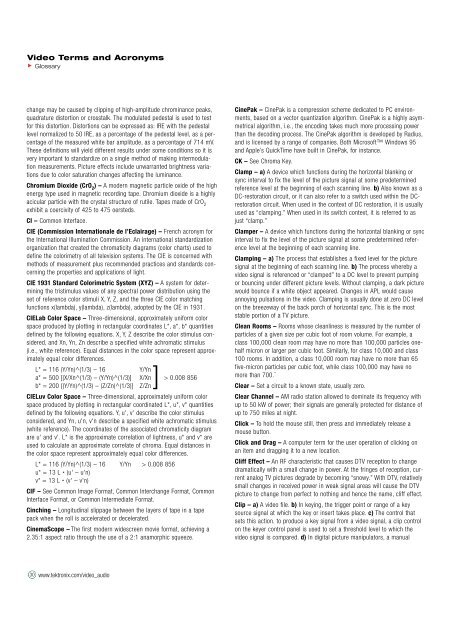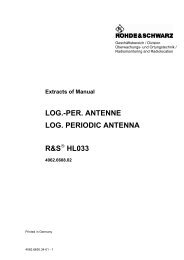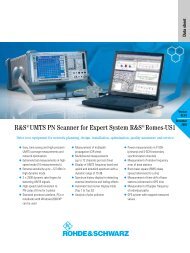Glossary of Video Terms and Acronyms - Isotest
Glossary of Video Terms and Acronyms - Isotest
Glossary of Video Terms and Acronyms - Isotest
You also want an ePaper? Increase the reach of your titles
YUMPU automatically turns print PDFs into web optimized ePapers that Google loves.
<strong>Video</strong> <strong>Terms</strong> <strong>and</strong> <strong>Acronyms</strong><br />
<strong>Glossary</strong><br />
change may be caused by clipping <strong>of</strong> high-amplitude chrominance peaks,<br />
quadrature distortion or crosstalk. The modulated pedestal is used to test<br />
for this distortion. Distortions can be expressed as: IRE with the pedestal<br />
level normalized to 50 IRE, as a percentage <strong>of</strong> the pedestal level, as a percentage<br />
<strong>of</strong> the measured white bar amplitude, as a percentage <strong>of</strong> 714 mV.<br />
These definitions will yield different results under some conditions so it is<br />
very important to st<strong>and</strong>ardize on a single method <strong>of</strong> making intermodulation<br />
measurements. Picture effects include unwarranted brightness variations<br />
due to color saturation changes affecting the luminance.<br />
Chromium Dioxide (CrO2 ) – A modern magnetic particle oxide <strong>of</strong> the high<br />
energy type used in magnetic recording tape. Chromium dioxide is a highly<br />
acicular particle with the crystal structure <strong>of</strong> rutile. Tapes made <strong>of</strong> CrO2 exhibit a coercivity <strong>of</strong> 425 to 475 oersteds.<br />
CI – Common Interface.<br />
CIE (Commission Internationale de l’Eclairage) – French acronym for<br />
the International Illumination Commission. An international st<strong>and</strong>ardization<br />
organization that created the chromaticity diagrams (color charts) used to<br />
define the colorimetry <strong>of</strong> all television systems. The CIE is concerned with<br />
methods <strong>of</strong> measurement plus recommended practices <strong>and</strong> st<strong>and</strong>ards concerning<br />
the properties <strong>and</strong> applications <strong>of</strong> light.<br />
CIE 1931 St<strong>and</strong>ard Colorimetric System (XYZ) – A system for determining<br />
the tristimulus values <strong>of</strong> any spectral power distribution using the<br />
set <strong>of</strong> reference color stimuli X, Y, Z, <strong>and</strong> the three CIE color matching<br />
functions x(lambda), y(lambda), z(lambda), adopted by the CIE in 1931.<br />
CIELab Color Space – Three-dimensional, approximately uniform color<br />
space produced by plotting in rectangular coordinates L*, a*, b* quantities<br />
defined by the following equations. X, Y, Z describe the color stimulus considered,<br />
<strong>and</strong> Xn, Yn, Zn describe a specified white achromatic stimulus<br />
(i.e., white reference). Equal distances in the color space represent approximately<br />
equal color differences.<br />
L* = 116 (Y/Yn)^(1/3) – 16 Y/Yn<br />
a* = 500 [(X/Xn^(1/3) – (Y/Yn)^(1/3)] X/Xn > 0.008 856 ] b* = 200 {(Y/Yn)^(1/3) – (Z/Zn)^(1/3)] Z/Zn<br />
CIELuv Color Space – Three-dimensional, approximately uniform color<br />
space produced by plotting in rectangular coordinated L*, u*, v* quantities<br />
defined by the following equations. Y, u', v' describe the color stimulus<br />
considered, <strong>and</strong> Yn, u'n, v'n describe a specified white achromatic stimulus<br />
(white reference). The coordinates <strong>of</strong> the associated chromaticity diagram<br />
are u' <strong>and</strong> v'. L* is the approximate correlation <strong>of</strong> lightness, u* <strong>and</strong> v* are<br />
used to calculate an approximate correlate <strong>of</strong> chroma. Equal distances in<br />
the color space represent approximately equal color differences.<br />
L* = 116 (Y/Yn)^(1/3) – 16 Y/Yn > 0.008 856<br />
u* = 13 L * (u' – u'n)<br />
v* = 13 L * (v' – v'n)<br />
CIF – See Common Image Format, Common Interchange Format, Common<br />
Interface Format, or Common Intermediate Format.<br />
Cinching – Longitudinal slippage between the layers <strong>of</strong> tape in a tape<br />
pack when the roll is accelerated or decelerated.<br />
CinemaScope – The first modern widescreen movie format, achieving a<br />
2.35:1 aspect ratio through the use <strong>of</strong> a 2:1 anamorphic squeeze.<br />
30 www.tektronix.com/video_audio<br />
CinePak – CinePak is a compression scheme dedicated to PC environments,<br />
based on a vector quantization algorithm. CinePak is a highly asymmetrical<br />
algorithm, i.e., the encoding takes much more processing power<br />
than the decoding process. The CinePak algorithm is developed by Radius,<br />
<strong>and</strong> is licensed by a range <strong>of</strong> companies. Both Micros<strong>of</strong>t Windows 95<br />
<strong>and</strong> Apple’s QuickTime have built in CinePak, for instance.<br />
CK – See Chroma Key.<br />
Clamp – a) A device which functions during the horizontal blanking or<br />
sync interval to fix the level <strong>of</strong> the picture signal at some predetermined<br />
reference level at the beginning <strong>of</strong> each scanning line. b) Also known as a<br />
DC-restoration circuit, or it can also refer to a switch used within the DCrestoration<br />
circuit. When used in the context <strong>of</strong> DC restoration, it is usually<br />
used as “clamping.” When used in its switch context, it is referred to as<br />
just “clamp.”<br />
Clamper – A device which functions during the horizontal blanking or sync<br />
interval to fix the level <strong>of</strong> the picture signal at some predetermined reference<br />
level at the beginning <strong>of</strong> each scanning line.<br />
Clamping – a) The process that establishes a fixed level for the picture<br />
signal at the beginning <strong>of</strong> each scanning line. b) The process whereby a<br />
video signal is referenced or “clamped” to a DC level to prevent pumping<br />
or bouncing under different picture levels. Without clamping, a dark picture<br />
would bounce if a white object appeared. Changes in APL would cause<br />
annoying pulsations in the video. Clamping is usually done at zero DC level<br />
on the breezeway <strong>of</strong> the back porch <strong>of</strong> horizontal sync. This is the most<br />
stable portion <strong>of</strong> a TV picture.<br />
Clean Rooms – Rooms whose cleanliness is measured by the number <strong>of</strong><br />
particles <strong>of</strong> a given size per cubic foot <strong>of</strong> room volume. For example, a<br />
class 100,000 clean room may have no more than 100,000 particles onehalf<br />
micron or larger per cubic foot. Similarly, for class 10,000 <strong>and</strong> class<br />
100 rooms. In addition, a class 10,000 room may have no more than 65<br />
five-micron particles per cubic foot, while class 100,000 may have no<br />
more than 700.¨<br />
Clear – Set a circuit to a known state, usually zero.<br />
Clear Channel – AM radio station allowed to dominate its frequency with<br />
up to 50 kW <strong>of</strong> power; their signals are generally protected for distance <strong>of</strong><br />
up to 750 miles at night.<br />
Click – To hold the mouse still, then press <strong>and</strong> immediately release a<br />
mouse button.<br />
Click <strong>and</strong> Drag – A computer term for the user operation <strong>of</strong> clicking on<br />
an item <strong>and</strong> dragging it to a new location.<br />
Cliff Effect – An RF characteristic that causes DTV reception to change<br />
dramatically with a small change in power. At the fringes <strong>of</strong> reception, current<br />
analog TV pictures degrade by becoming “snowy.” With DTV, relatively<br />
small changes in received power in weak signal areas will cause the DTV<br />
picture to change from perfect to nothing <strong>and</strong> hence the name, cliff effect.<br />
Clip – a) A video file. b) In keying, the trigger point or range <strong>of</strong> a key<br />
source signal at which the key or insert takes place. c) The control that<br />
sets this action. to produce a key signal from a video signal, a clip control<br />
on the keyer control panel is used to set a threshold level to which the<br />
video signal is compared. d) In digital picture manipulators, a manual





